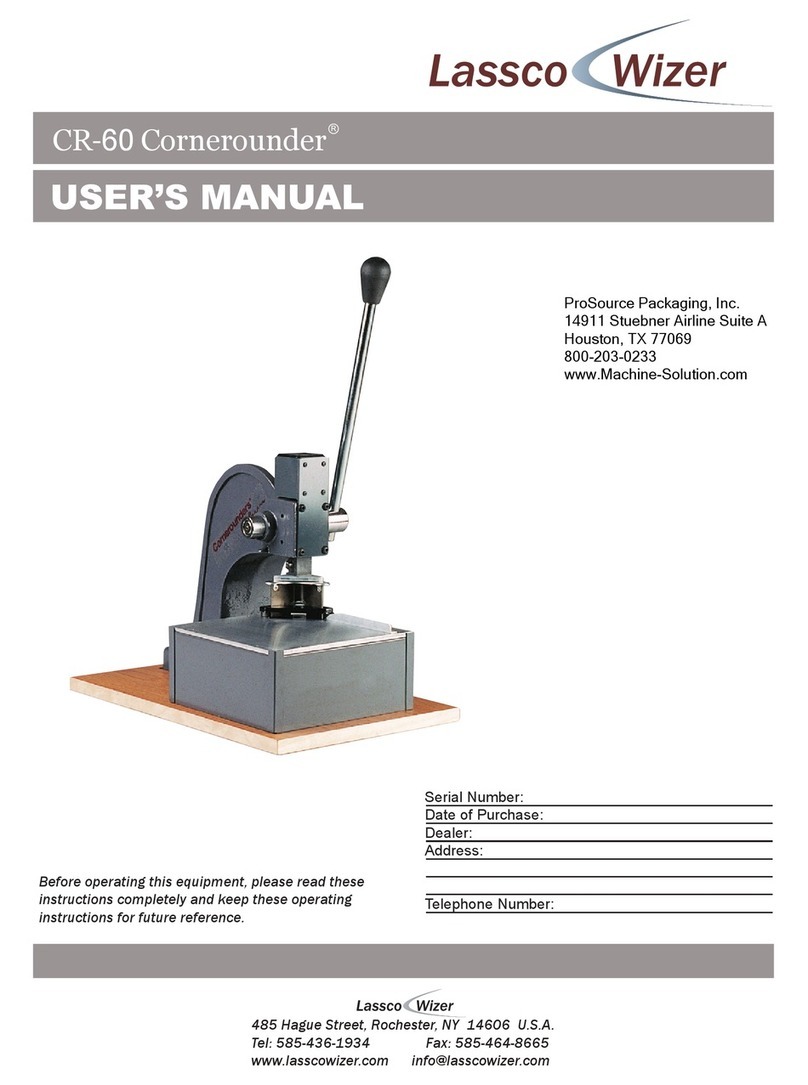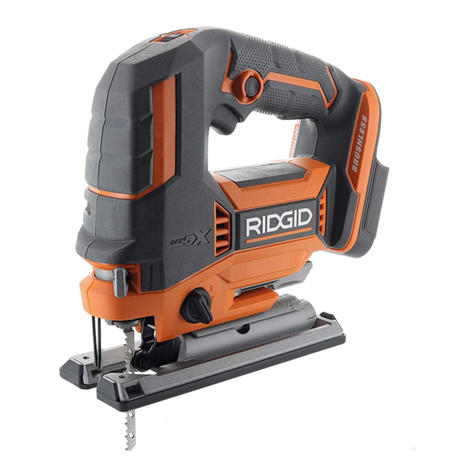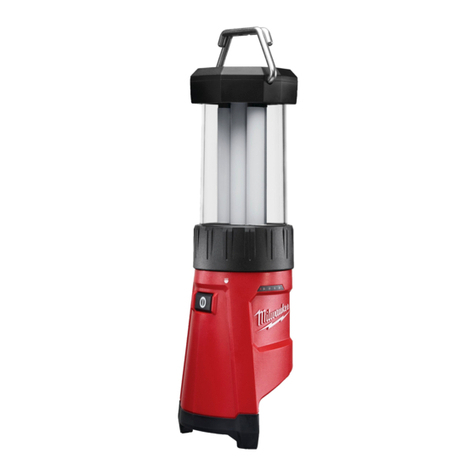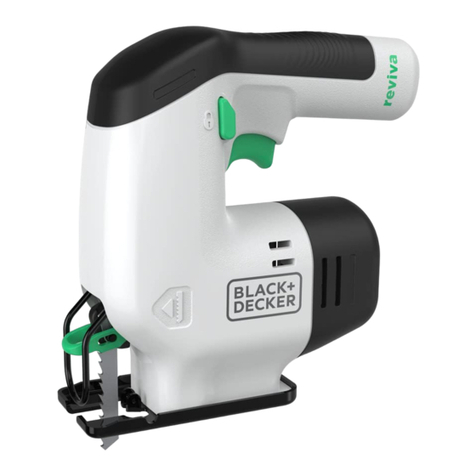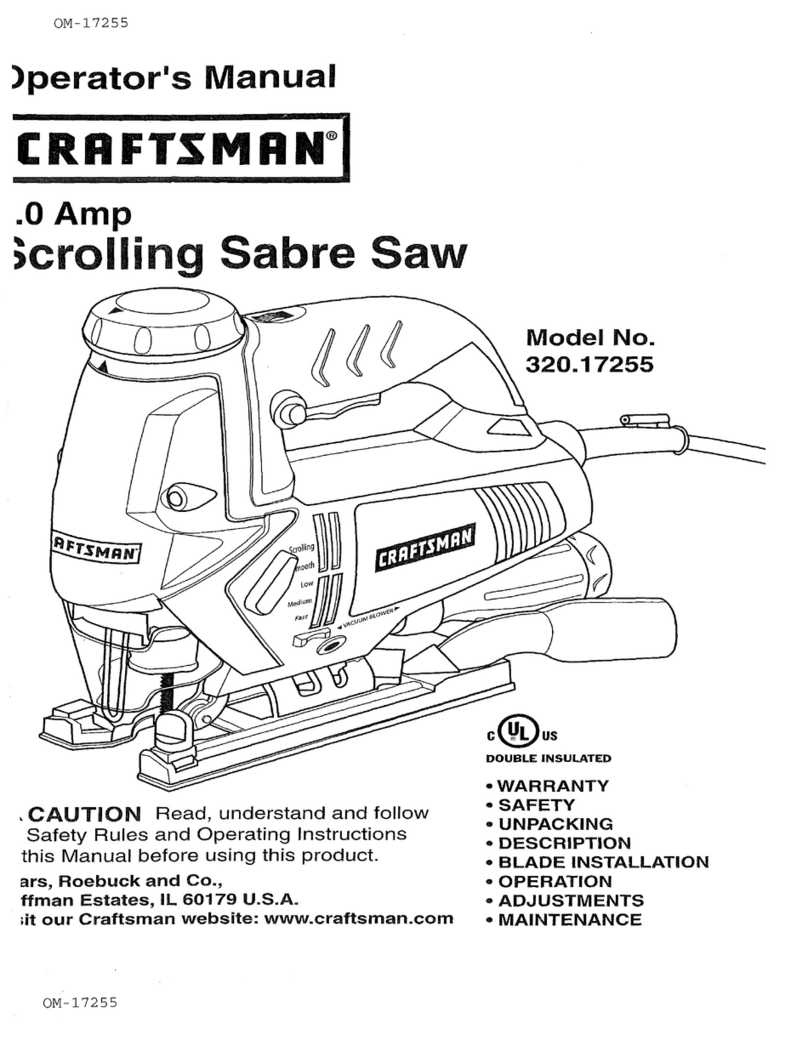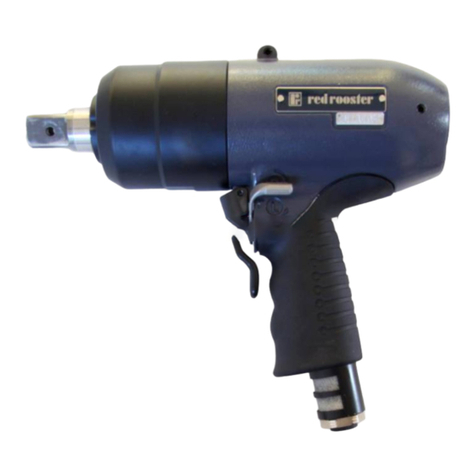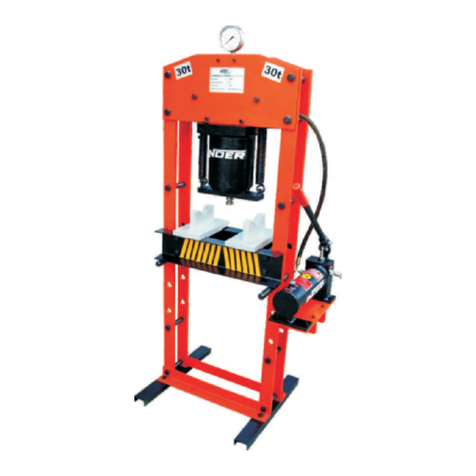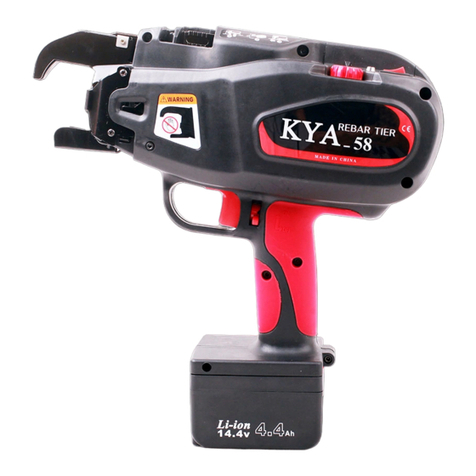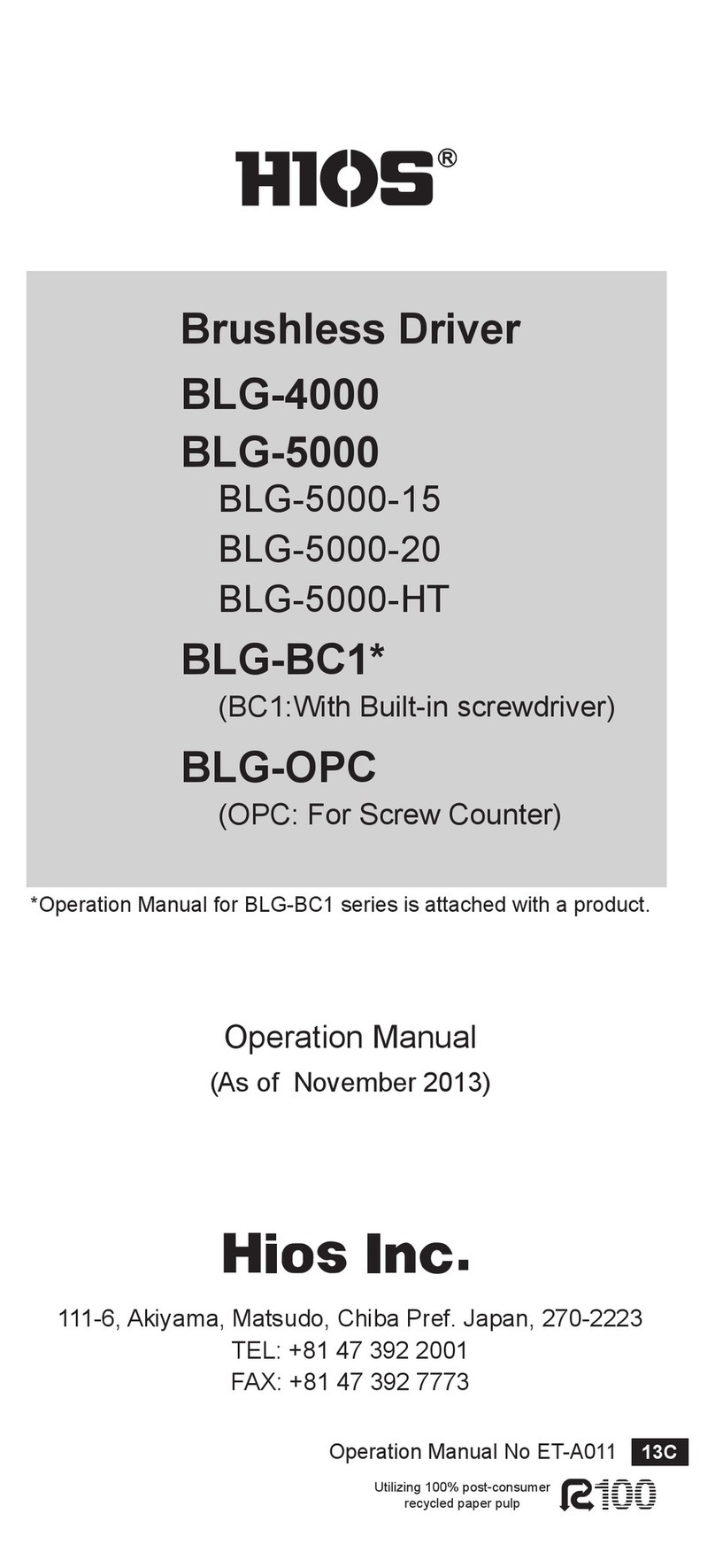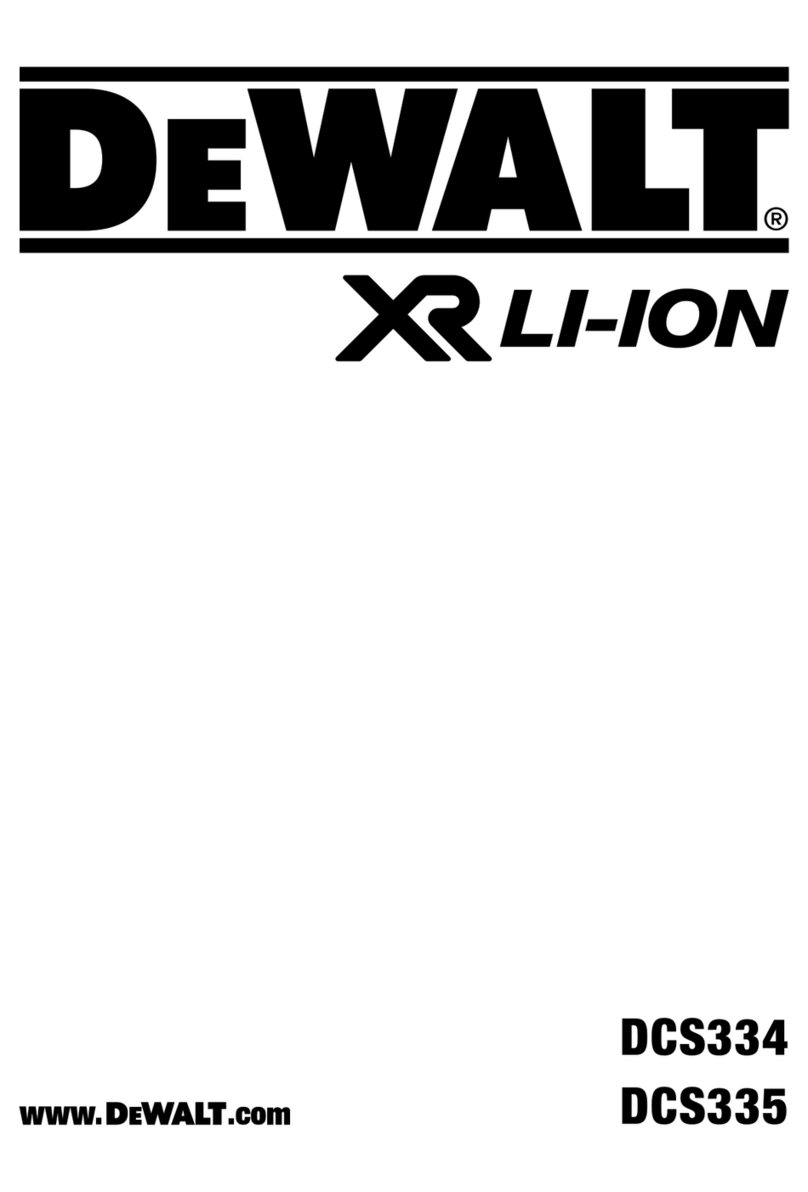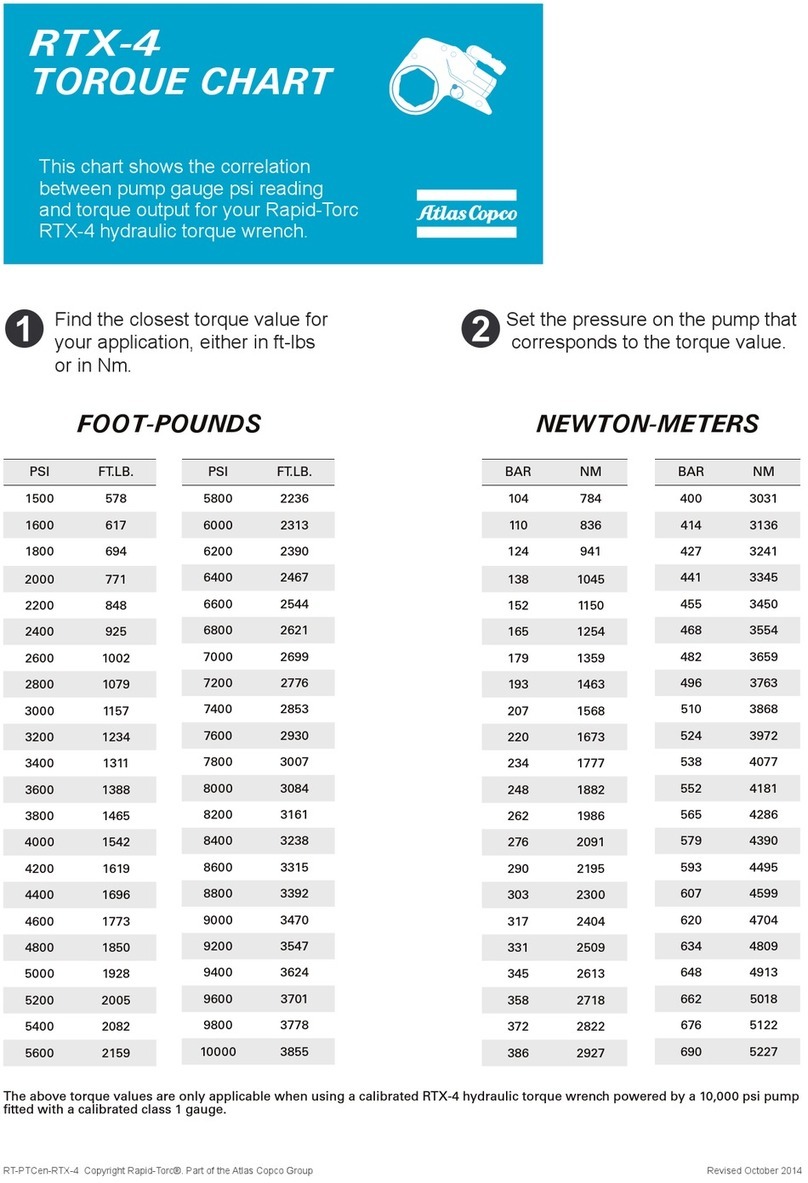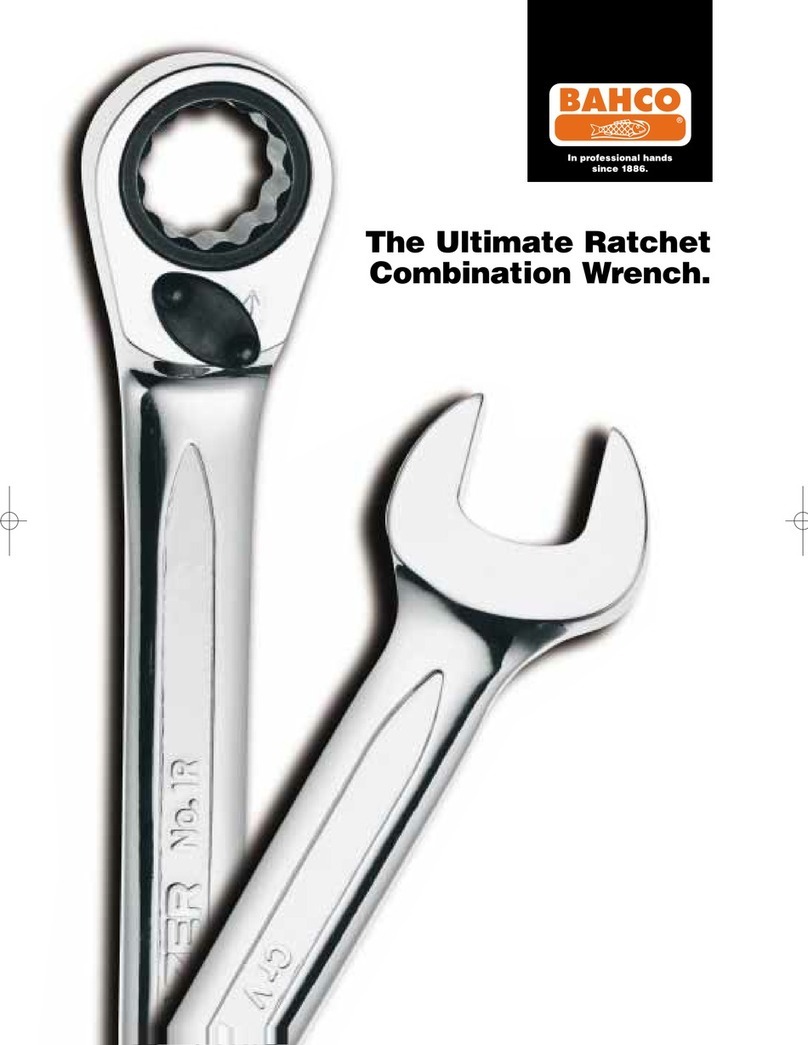Geo Knight Digital DK20 16x20 User manual

1
Digital Knight
16x20 and 14x16
Digital Clamshell

2
Table of Contents
TableofContents.................................................. 2
Introduction.......................................................... 3
Setup&Suggestions............................................. 4
BasicUse.............................................................. 4
SettingTime.......................................................... 4
SettingTemperature .............................................. 5
SettingHeight / Pressure....................................... 6
Guidelines&Standard Settings............................. 7
ProgrammablePresets .......................................... 8
UserOptionsMenu............................................... 9
Fahrenheit/Celsius .............................................. 9
TimerCounter ...................................................... 9
RecordedPressings............................................... 9
Height Gauge - High Point ................................. 10
Height Gauge - Low Point .................................. 10
Pressure/HeightGaugeSensitivity .................... 10
DropSense ......................................................... 10
Beep ................................................................... 11
Alarms ................................................................ 11
InterchangeableTables ........................................ 12
Maintenance........................................................ 12
Troubleshooting.................................................. 13
Troubleshooting(cont.) ...................................... 14
LimitedWarranty ................................................ 15

3
Introduction
Congratulations on your purchase of the DK20 16x20 or DK16
14x16 clamshell press! This heat press machine has many exciting
features, all of which are meant to help make your heat transfer
pressing endeavors as successful and easy as possible. Please take
the time now to thoroughly read through this manual to become
acquainted with them. It will explain some key features, concepts
and methods that will save much time and effort in using this press
and in your heat pressing applications.
Throughout this manual, many areas and components of this
machine will be referred to by specific names. Please refer to the
illustrations below in order to become familiar with some of the
terminology used in this manual.
Controller
Pressure Knob
Gas Shock
Clamp/Linkage
Heat Platen
Handle
LowerTable
SiliconePad
Base
Temperature
°Far/°Cel Indicator
Ready Indicator
Heating Indicator
Open Indicator
Timing Indicator
Done Indicator
Time
TEMP Button
PRG Button
Up/Down Arrows
Default Operating Mode of Controller

4
Setup & Suggestions
• Locate the press on a firm, sturdy work surface. It is recommended
that the front two holes on the feet of the machine be bolted down for
best ease-of-use.
• The height of the bench/work space the press is located on would be
ideally 27” to 32” high.
• Attach the power cord from the rear to the backside of the controler.
There is a power inlet on the back panel of the control box for the
power cord.
• The press should remain in the unclamped/open position when not in
use. Do not leave the heater block closed on the table surface when
hot for long periods of time if not using. The top platen may either be
open, or fully retracted backwards when not in use.
Basic Use
Setting Time
Thetimesettingis always editable in thedefaultoperating mode
of the controller. The left two digits of the time display are minutes.
The right two digits are seconds. This can be changed to Hours/
Minutes in the User Options Menu.
• Use the Up & Down arrow keys to change the time.
• Hold the Up or Down arrow key down to increment the values quickly.
After a brief pause, the values will accelerate.
• Press the Up & Down arrow keys together to clear the setting to 00:00
• When the press is closed, the timing cycle starts. The “TIMING”
indicator will appear.
• When the timing cycle is finished, the “DONE” indicator will appear.
• Dependingon thetimer alarmchosen, thealarm may continueto sound
at the end of the timing cycle until the press is opened.
• When the press is opened up, the “OPEN” indicator will appear.

5
Setting Temperature
• The control will regulate the heat platen temperature based on the set
point temperature. When the temperature falls below the Set Point,
the “HEATING” indicator will appear.
• Whenthe temperaturereaches theSet Point, the“HEATING” indicator
will disappear and the “READY” indicator will appear.
• If the Set Point temperature is set to a temperature below the Current
temperature, the press will wait to cool down to that Set Point. At that
time, neither the “READY” or “HEATING” indicators will appear.
In the default operating mode of the controller, the displayed
temperatureisthe Currenttemperature.This is theactualtemperature
of the heat platen surface. Please note that the operating range of the
controller is from 150°F to 550°F (65°C to 288°C). During the first
heat up cycle of the press, the controller will display 150°F (65°C)
until the heat platen temperature rises above that temperature.
The Set Point temperature is the temperature the operator sets
the press for. This is the value the press will regulate the Current
temperature based on. The set point temperature may be changed
whenever necessary:
• When in the default operating mode, press the TEMP button.
• The Current temperature will be replaced by the blinking Set Point
temperature.
• Use the Up & Down arrow keys to change the Set Point temperature.
• Hold the Up or Down arrow key down to increment the values quickly.
After a brief pause, the values will accelerate.
• Press the Up & Down arrow keys together to set the temperature to
350.
• Whenfinished settingthe temperature,press the TEMPbutton toreturn
to the default operating mode.

6
TheDigitalHeight/Pressuregaugeisahelpfulindicatorofthecurrent
heightofthe top headasthe operator adjuststhepressure.
• To decrease the pressure, turn the
pressure knob to the right,
clockwise.
• The top head will rise away from
the lower table.
• To increase the pressure, turn the
pressure knob to the left,
counterclockwise.
• Thetop headwill lower towardthe
pressing table.
CAUTION: The heat platen will become
detached from the frame and drop onto
the table if it is adjusted too far. Please
use cation when turning the knob to the
left (unscrewing: counter-clockwise).
Setting Height / Pressure

7
Guidelines & Standard Settings
The following information covers some basic guidelines for
pressing, as well as some generic parameters for basic heat transfer
applications.
• Whenpressing shirts,it isoften recommended thatthe shirtsbe quickly
pressedfor 2seconds beforetransferring toremove wrinkles andwater
content.
• When pressing two sides of a garment, pull the garment over the table
so that the printed side drapes underneath the table. This will avoid
reheatingpreviously transferreddesigns on oppositesides ofgarments.
It will also avoid any bleed-through of inks on lighter fabrics.
• Avoid laying collars, cuffs, zippers, and other bulky parts of garments
on the lower table, as these can adversely affect pressing conditions,
and reduce the life of the silicone pad.
• When pressing rigid substrates (plastics, metals, woods, etc.), be sure
that any protective films or laminates are removed before heating.
• Always check that the transfer image is face down against the material,
to avoid sealing the image against the heat platen instead of the
substrate.
Always follow the transfer media suppliers instructions when
pressing. The information below is for general reference only, and
may not be as accurate as the instructions provided by the transfer
media & imprintable substrate supplier.
• Hot Split Supplier Transfers 350-375°F, 8-10 secs
• Puff Transfers 350-375°, 5-7 secs (extra heavy pressure)
• Ink-Jet Transfer Papers 360°, 15-18 secs
• ColorCopy/Laser Transfer Papers 375°, 20-25 secs
• Sublimation Inks (Polyester Fabrics) 400°, 35 secs
• Sublimation Inks (Plastics) 400°, 1 min, 15 secs
• Sublimation Inks (Metals) 400°, 1 min
• Sublimation Inks (Woods) 400°, 1 min, 15 secs
• Sublimation Inks (Ceramics) 400°, 4 min

8
Programmable Presets Normal Default Mode
Presets Mode
Edit Preset Temp
EditPresetPressure/Height
Programmable presets are stored
programs where commonly used
Temperature, Time and Height
(pressure) settings can be stored and
retrieved.
Presets can be recalled simply by
pressing the PRG key, selecting the
program desired with the arrow keys,
and pressing the PRG key again. This
will update the current settings on the
press with the settings in the preset.
Presets can be edited by pressing
the TEMP key while inside the programs.
When the display shows “SEt”, press
the TEMP key to change the
temperature, time and PRS (height)
settings for that preset. The TEMP key
moves the flashing value from Temp to
Time to PRS and back to “SEt”. The
arrow keys change the value.
So... the PRG key enters into the
presets, and also exits the presets. When
exiting the presets, the press’
temperature & time is updated with the
values that were stored in the preset,
and the PRS display tells the operator
what height level to adjust the pressure
to.
Press PRG
○○○○○○○○○○○○○○○○○○○○○○○
Edit Preset Time
Press TEMP
Press PRG Press TEMP Press TEMP Press TEMP

9
User Options Menu
Theuseroptionsmenu is a set offeaturesand calibration options
that are programmable and adjustable by the user. It consists of a set
of menu items that can be scrolled through. Each menu item is a
feature whose values can be veiwed and /or changed. To enter the
user options menu:
• From the default operating mode, press the TEMP & PRG keys
simultaneously.
• If the keys are not pressed exactly at the same time, you may enter the
temperature edit mode, or the presets mode. Exit either of those modes
and try again.
• To cycle from one menu item to the next, press PRG.
Fahrenheit / Celsius
The Current, Set Point, and Preset
temperature values can be displayed in
Fahrenheit or Celsius. To change the value to
F or C, use the arrow keys. Press PRG to move
tothenext menuitem.
Timer Counter
The timer displays as factory default
Minutes:Seconds. This can be changed to
Hours:Minutes. To change to value to HR
(hours:mins)orMIN (mins:secs),usethe arrow
keys. Press PRG to move to the next menu
item.
Recorded Pressings
The digital control records the number of
pressing cycles completed. This can be very
helpful when counting the number of full
pressings that have been performed. The value
will scroll from left to right. A “-” sign will
separate the beginning and end of the number.
To reset the count to Zero, press an arrow key.
Press PRG to move to the next menu item.

10
Height Gauge - High Point
Thisfeatureis notapplicableon thispress.
Press PRG to skip this menu item.
Height Gauge - Low Point
Thisfeatureisnotapplicable onthispress.
Press PRG to skip this menu item.
Pressure / Height Gauge Sensitivity
Drop Sense
Thisfeatureis notapplicableon thispress.
Press PRG to skip this menu item.
Atemperaturealarmisavailableforwarningtheuserofout-of-range
temperatureconditions.Theusercansetthismenuitemtosoundanalarm
iftheheatplaten drops below theSetPoint temperature by theamount
indicated. This can be helpful when pressing substrates that absorb an
unusuallylargeamountofheat, causingtheplatentofall intemperature
quickly. Ifthe resultsofthetransferbegin todeteriorate, theDropSense
featurecan helptheuseravoidthis.
Usethearrow keys tosetthe degrees orto
turnthisfeatureoff. If the Current temperature
dropsbelowtheSetPointbythisamountormore,
analarm willsound.ThedefaultvalueisOFF.

11
Beep
Normally, all buttons on the keypad beep
when pressed. This can be turned off, so all
buttonkeypressesaresilent.Use thearrow keys
to turn this feature On or Off.
Alarms
There are 10 different alarms available to choose from. These
alarms are sounded at the end of the timing cycle, as well as if the
Drop Sense feature is enabled.
Use the arrow keys to change the values
ortoturn thealarmoff.Please notethedifferent
alarms below.
• denotes a short beep.
_ denotes a longer beep.
~ denotes infinte loop.
Alarm # AlarmPattern
Off No alarm
01 • • • _
02 • • • _ ~
03 • • _
04 • • _ ~
05 • • •
06 • • • ~
07 _ ~
08 _
09 •
10 • (shorter)

12
Interchangeable Tables
Thelower tableonthemachineisinterchangeable.Different sized
optional tables can be obtained for various materials & handling
requirements.
The tables simply fit right
onto the table support. The sides
of the angle brackets on the
underside of the table will slide
along the sides of the square
tubing of the table support. Make
surethesmall barstripfalls inside
the table support tubing.
Maintenance
Themajorityofthe press hasbeendesigned to be asmaintenance
free as possible. There are only a few aspects of the machine that
should be monitored to insure proper operation.
• The pressure adjustment screw is the area of greatest wear and stress
on the machine and should be checked occaisionally for loss of
threading. Detach the heat platen from the frame by turning the knob
to the left, counterclockwise, and check the threads of the pressure
screw and the pressure block it screws into.
• Check the cord regularly to make sure there are no visible signs of
damage. Make sure the modular cord does not come in contact with
the heater.
• The silicone pad on the lower table can degrade after much use and
over an extended period of time. This pad is replaceable. If the pad
becomes dried out, cracked, or there are chunks removed from the
silicone pad, this can result in inconsistent and poor quality transfers.

13
Troubleshooting
Thefollowinginformation attempts toaddressthe most probable
mechanical and user issues with the press. Most issues with heat
transfer presses are application related. That is, they have to do with
theresults ofaparticulartransferapplication.
Fortechnicalsupportonproblemshavingtodowiththefinalresults
ofa particulartransfer paperormedia,pleasecontactthesupplierofthat
transfermedia.Generally,themachinerymanufacturerisunabletosupport
themyriad ofdifferent transferpapers, inksand imprintableitems onthe
marketfrom otherresellers.
Q. The timer does not start when I close the heat platen, or the timer does
not reset when I open the press up.
A. There are several probable causes for this. The timer is activated by a
micro-tilt-sensor stuck to the pressure arm. First: When the head of
the machine is opened, the tilt sensor needs to be tilted slightly upward
to signal the controller to stop/reset. When the head of the machine is
closed, the timer sensor needs to be tilted downward (towards the
floor) to signal the controller to start counting. Second: Check the wire
connection from the tilt sensor into the control panel. The timer &
pressure signals go to a small black 6-pin connector on the top of the
circuit board in the control box. Check to make sure this is firmly
seated and plugged into the board.
Q. The control displays Err when it first comes on, and I can not set the
temperature or use the press.
A. The Err message will display if the heating signal from the platen has
been cut off, interrupted, or the heating sensor has failed. First check
the green heat connector that plugs into the digital control. This is
inside the top head. Open up the control box and unplug the green
connector at the top of the circuit board. This is the temperature sensor
wire. Remove the two wires from the green plug, cut & strip them for
fresh connections, and reconnect them to the green plug. DO NOT
SWITCH the leads - they must go to the same location on the green
plug. Make sure the wires can not be pulled out of the green plug and
then reconnect the green plug to the circuit board. Contact the factory
if the Err message continues.

14
Troubleshooting (cont.)
Q. I press the keys on the keypad, and there is no sound or response from
the controller.
A. Check the connection of the keypad to the controller. This is inside
the top panel. Unplug the power cord. Remove the two screws in
between the clamp/linkage that hold down the top panel, and carefully
lift the panel up and look inside at the digital controller. The keypad
connector passes in through the top panel. It should wind around the
first circuit board and be seated fully into the connector. Check the
black keypad connector that plugs into the circuit board to see if it has
pulled apart. Also check the area where the keypad connects to the
front membrane to see if the leads have been damaged. The membrane
keypad may need to be replaced.
Q. The gas springs are not lifting the head as easily as when the press
was new, or the gas springs have lost their pressure.
A. After a large volume of use, and over an extended period of time of
many, many pressing cycles, the gas springs will slowly loose their
original force. These hydraulic lifter springs are extremely easy to
replace, and are a surprisingly similar or even lower cost than
conventional mechanical springs. Contact the factory for replacement
gas springs if it is not able keep the platen open. The gas springs must
have the silver rod Face Down, and the black tube Face Up.
Q. The press has shut off, and will not come back on after checking the
power cord, on/off switch, etc.
A. Check the fuse. In the back panel of the control box, the power cord
socket has a built-in fuse-holder. Unplug the power cord, and gently
pry out the fuse-holder. If the fuse is burnt out or there is no continuity,
replaceit. Ifthe fuse isfine, checkthe black andwhite wireconnections
from the power socket to the on/off switch, and from the on/off switch
to the controller.
Q. I pressed a transfer upside down. The inks and transfer material have
burned onto the heat platen.
A. Cool the press down. Using a nonabrasive detergent or cleaner,
thoroughly scrub the heat platen surface. Do not use steel wool, or a
pad that will scratch the Teflon coating of the platen. Test whatever
you use to make sure you will not remove the Teflon coating from the
heat platen. If you are still unable to remove the transfer material,
obtain teflon heater block cleaner from the contact information located
at the end of this manual.

15
Geo Knight & Co Inc
52 Perkins St, Brockton MA02302 USA
(508)588-0186 - Fax (508) 587-5108
[email protected]-www.heatpress.com
Limited Warranty
Geo Knight & Co warrants that the press is free from defects in both material and
workmanship One Year from the date of invoice to the buyer. If any parts or workmanship are found to
bedefectiveinmanufacture, Geo Knight &Cowillrepair or replace thedefectiveparts or workmanship.
In addition, Geo Knight & Co warrants that the Digital Knight heat control is free from defects in both
material & workmanship and is covered under no-charge support for (3) years. Geo Knight & Co also
warrants that the heating element is warranted for the lifetime of the press, provided it is owned by the
original purchaser. This lifetime warranty on the heating element does not cover temperature sensor
failure, damage or disconnection. This warranty covers all parts to repair the defects, except when
damage results from accident, alteration, misuse or abuse, or when the machine has been improperly
installed, or modified in any way. If the press becomes defective during the limited warranty period of
one year for the entire press, three years for the control, or the lifetime of the heating element, Geo
Knight & Co reserves the right to recall the defective press to the factory for repairs if on site component
replacement is deemed not possible by Geo Knight & Co. A return authorization must be granted by
Geo Knight & Co prior to its return.
If a press covered by the one year limited warranty must be returned to the factory for
repairs, Geo Knight & Co shall make every effort to repair buyer’s press. However, Geo Knight & Co
reserves the exclusive right to determine whether to repair or replace a defective press. If Geo Knight
& Co authorizes a replacement press, the warranty of the replacement press shall expire on the
anniversary date of the original machine’s invoice to the buyer.
There are no warranties which extend beyond the description on the face hereof. Seller
disclaimsanyimplied warranty of merchantabilityand/orany implied warrantyoffitness for aparticular
purpose, and buyer agrees that the goods are sold “as is”. Geo Knight & Co does not warrant that the
functions of the press will meet the buyers requirements or expectations. The entire risk as to use,
quality and performance of the press lies with the buyer. In no event will Geo Knight & Co be liable
for any damages, including loss of profits, destruction of goods or any other special, incidental,
consequential or indirect damages arising from the use of the press or accompanying materials. This
limitation will apply even if Geo Knight & Co or its authorized agent has been advised of the possibility
of such damage.

16
This manual suits for next models
1
Table of contents
Other Geo Knight Power Tools manuals

Geo Knight
Geo Knight JetPress 14 User manual

Geo Knight
Geo Knight Digital Combo DC16 User manual
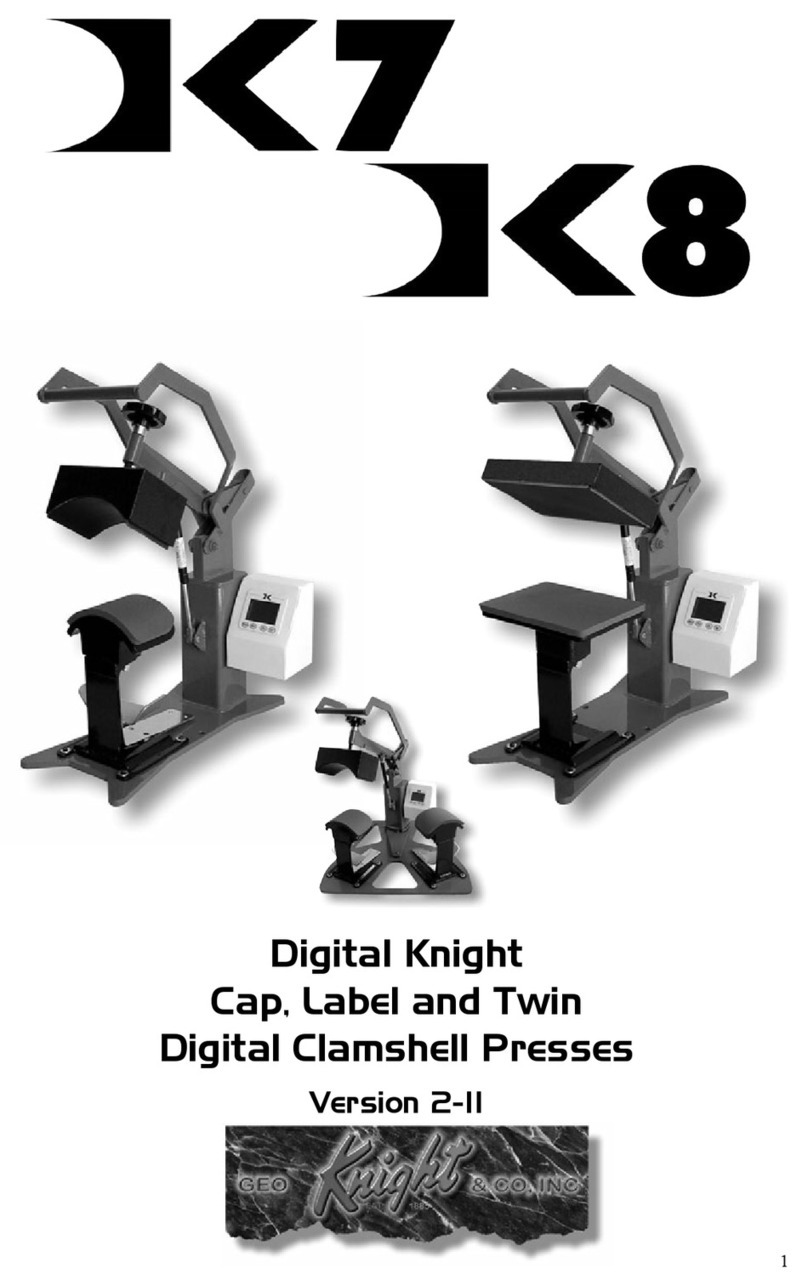
Geo Knight
Geo Knight DK7 User manual

Geo Knight
Geo Knight DC16AP User manual

Geo Knight
Geo Knight Digital Knight DK3 User manual
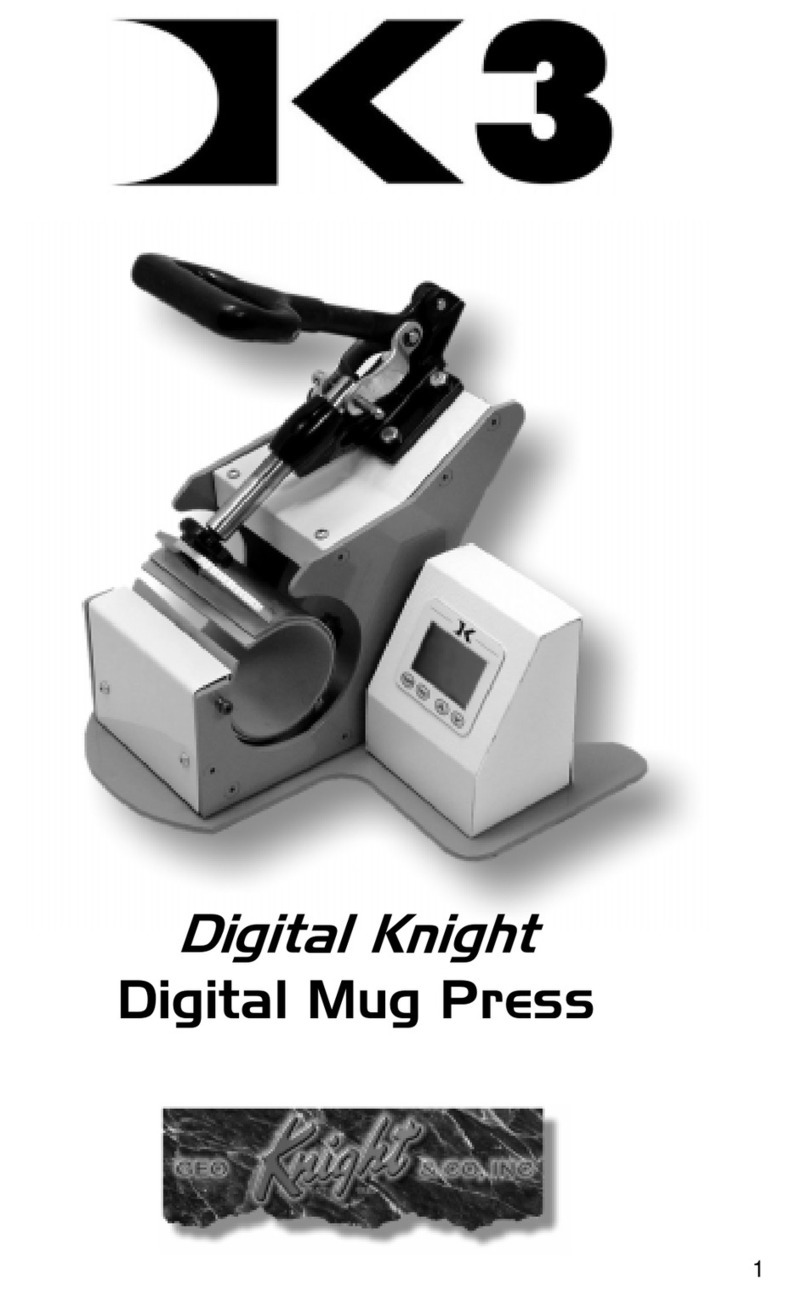
Geo Knight
Geo Knight Digital Knight DK3 User manual

Geo Knight
Geo Knight JETPRESS 14 User manual
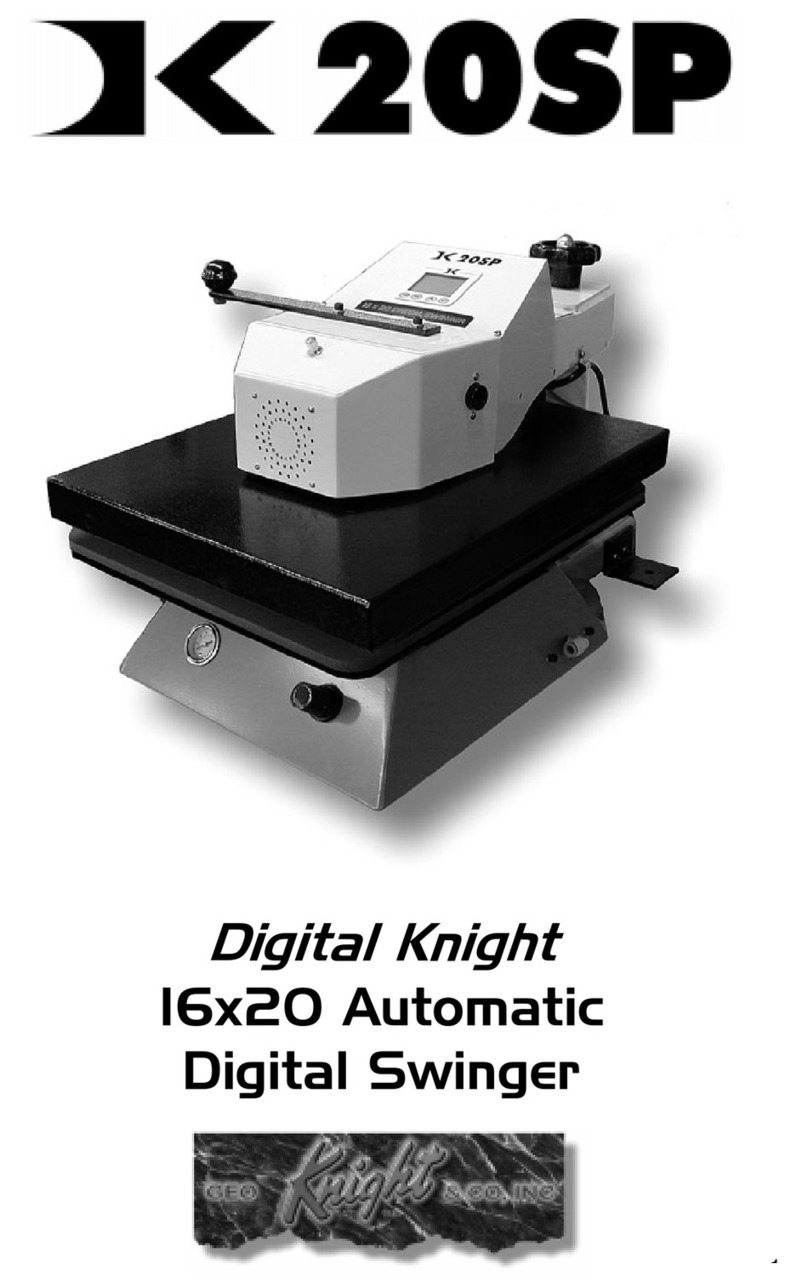
Geo Knight
Geo Knight Digital Knight DK20SP User manual
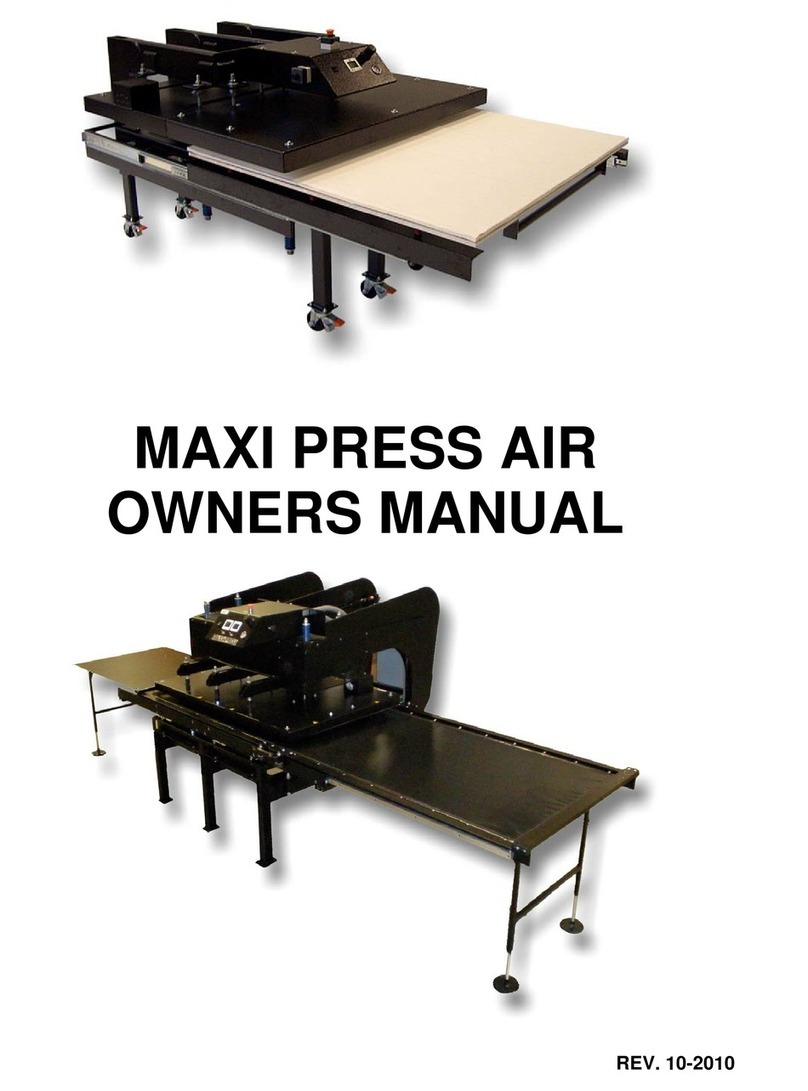
Geo Knight
Geo Knight Maxi Press Air User manual

Geo Knight
Geo Knight Digital Knight DK20 User manual

